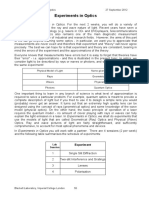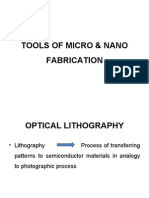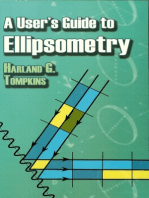0 ratings0% found this document useful (0 votes)
24 views5 X-Ray Lithography - 1
5 X-Ray Lithography - 1
Uploaded by
Rama SubramaniyanThe document discusses the setup and advantages and limitations of proximity x-ray lithography. X-ray lithography uses soft x-rays with wavelengths of 10s of nanometers down to less than 1 angstrom, allowing for very fine features with vertical sidewalls and a large depth of focus. However, x-ray lithography has limitations including the difficulty of fabricating x-ray masks and finding strong, stable, collimated single-frequency x-ray sources. The resolution is also still limited by diffraction effects and scattering of secondary electrons in the resist.
Copyright:
© All Rights Reserved
Available Formats
Download as PPTX, PDF, TXT or read online from Scribd
5 X-Ray Lithography - 1
5 X-Ray Lithography - 1
Uploaded by
Rama Subramaniyan0 ratings0% found this document useful (0 votes)
24 views5 pagesThe document discusses the setup and advantages and limitations of proximity x-ray lithography. X-ray lithography uses soft x-rays with wavelengths of 10s of nanometers down to less than 1 angstrom, allowing for very fine features with vertical sidewalls and a large depth of focus. However, x-ray lithography has limitations including the difficulty of fabricating x-ray masks and finding strong, stable, collimated single-frequency x-ray sources. The resolution is also still limited by diffraction effects and scattering of secondary electrons in the resist.
Original Description:
cghdgjfgnxfmxbnxbnxcbnxcvbzcvbncgfhmxfn
Original Title
5 X-ray Lithography_1 (1)
Copyright
© © All Rights Reserved
Available Formats
PPTX, PDF, TXT or read online from Scribd
Share this document
Did you find this document useful?
Is this content inappropriate?
The document discusses the setup and advantages and limitations of proximity x-ray lithography. X-ray lithography uses soft x-rays with wavelengths of 10s of nanometers down to less than 1 angstrom, allowing for very fine features with vertical sidewalls and a large depth of focus. However, x-ray lithography has limitations including the difficulty of fabricating x-ray masks and finding strong, stable, collimated single-frequency x-ray sources. The resolution is also still limited by diffraction effects and scattering of secondary electrons in the resist.
Copyright:
© All Rights Reserved
Available Formats
Download as PPTX, PDF, TXT or read online from Scribd
Download as pptx, pdf, or txt
0 ratings0% found this document useful (0 votes)
24 views5 pages5 X-Ray Lithography - 1
5 X-Ray Lithography - 1
Uploaded by
Rama SubramaniyanThe document discusses the setup and advantages and limitations of proximity x-ray lithography. X-ray lithography uses soft x-rays with wavelengths of 10s of nanometers down to less than 1 angstrom, allowing for very fine features with vertical sidewalls and a large depth of focus. However, x-ray lithography has limitations including the difficulty of fabricating x-ray masks and finding strong, stable, collimated single-frequency x-ray sources. The resolution is also still limited by diffraction effects and scattering of secondary electrons in the resist.
Copyright:
© All Rights Reserved
Available Formats
Download as PPTX, PDF, TXT or read online from Scribd
Download as pptx, pdf, or txt
You are on page 1of 5
Setup of proximity x-ray lithography
Mask is made of absorber (Au) on membrane (Si3N4)
X-ray lithography advantages
Wavelength: 10s nm (soft x-rays) down to 1 (subatomic).
Little diffraction effects when using such small .
No backscatter or reflections: very fine features with vertical sidewalls. Very large depth of focus: wafer with non-flat surface is OK. Simpler (in principle) than optical or e-beam lithography: no complex optics (dont really have x-ray optics now). All that needed is an x-ray source and an x-ray mask.
X-ray lithography limits
1X mask technology because refractive index for all materials is (almost) absolutely 1.0 (no lens for demagnification). (4 for DUV lithography, mask easier to make) X-ray mask difficult to fabricate with many issues: fragile, defects, aspect ratio, bending due to heating. Strong, stable, collimated, single frequency x-ray sources are hard to find. X-rays produced in synchrotrons fit this criteria, but with high cost and huge size. Resolution is still limited by Fresnel diffraction and scattering of secondary electrons in the resist. Typical resist is insensitive, need long time to expose.
w
h Aspect ratio=pattern height/width=h/w.
3
Comparison to other lithographies
Photolithography, diffraction limits resolution E-beam lithography (scattering, proximity effect)
X-ray lithography, little diffraction, high depth of focus
Ion beam lithography, low penetration depth (very thin resist)
The physics of microfabrication, I. Brodie and J. J. Murray, Plenum Press, 1982
X-ray lithography: resolution limit due to diffraction
Precise gap must be maintained: too close will damage membrane mask, too far reduce resolution. Although is very small, diffraction still present. Resolution limit due to diffraction R=3/2[(g+t/2)]1/2, g: gap; t: resist thickness. (This is the same resolution equation as for photolithography) E.g. 100nm feature size requires =1nm, g=4.4m (assume t<<g).
5 Cerrina, J Phys D, 2000
You might also like
- Production and Control of Scatter RadiationDocument120 pagesProduction and Control of Scatter RadiationMunish Dogra100% (2)
- Ideal Radiograph & Radiographic ErrorsDocument99 pagesIdeal Radiograph & Radiographic Errorsvanshika0% (1)
- Chapter 5 Lithography - IIDocument25 pagesChapter 5 Lithography - IIPriyabrataTaraiNo ratings yet
- X-Ray Lithography: Presented byDocument45 pagesX-Ray Lithography: Presented byMohammad RameezNo ratings yet
- Chapter 5 Lithography: 1. Light Source and Photomask, AlignmentDocument28 pagesChapter 5 Lithography: 1. Light Source and Photomask, AlignmentKhánh NguyễnNo ratings yet
- Radio 3Document8 pagesRadio 3meenaaljouburiNo ratings yet
- Optical Lithography PDFDocument16 pagesOptical Lithography PDFprashn80No ratings yet
- Chapter 5 Lithography: 1. Introduction and ApplicationDocument85 pagesChapter 5 Lithography: 1. Introduction and ApplicationTan Phuoc DuongNo ratings yet
- AP 2 Module 1Document31 pagesAP 2 Module 1Anshuman NandanNo ratings yet
- Nano-Electronics: S. MohajerzadehDocument33 pagesNano-Electronics: S. MohajerzadehAruna BharathiNo ratings yet
- Methods For Crystallographic CharacterizationDocument13 pagesMethods For Crystallographic Characterizationmuthurajan_hNo ratings yet
- Power Point Presentation On Lithography: Bachelor of Technology in Electronics Engineering Submitted by Narayan MishraDocument38 pagesPower Point Presentation On Lithography: Bachelor of Technology in Electronics Engineering Submitted by Narayan MishraNarayan Mishra MishraNo ratings yet
- Phase Angle (2 /) (Path Difference) 2 / (1/2 D Sin) D SinDocument59 pagesPhase Angle (2 /) (Path Difference) 2 / (1/2 D Sin) D SinanujayanNo ratings yet
- 9-Optics Experiments PDFDocument18 pages9-Optics Experiments PDFJuan Carlos TrujilloNo ratings yet
- LITHOGRAPHY-Chapter 5: - Litography Limits The Minimum Feature Size That Can Be Printable On The WaferDocument22 pagesLITHOGRAPHY-Chapter 5: - Litography Limits The Minimum Feature Size That Can Be Printable On The WafereniNo ratings yet
- Chapter 5 Lithography - I From WaterlooDocument22 pagesChapter 5 Lithography - I From WaterlooAdhi Cahyo WijayaNo ratings yet
- LithographyDocument24 pagesLithographyManoj Murthy100% (1)
- Phys213 Lec13Document22 pagesPhys213 Lec13nierautomata2457No ratings yet
- Screen-Film Radiography II: Characteristics of Film Screen-Film System Scattered RadiationDocument35 pagesScreen-Film Radiography II: Characteristics of Film Screen-Film System Scattered RadiationmanikantatssNo ratings yet
- Tools of Micro & Nano FabricationDocument39 pagesTools of Micro & Nano Fabricationkaushik4208100% (2)
- Part 1 NDT-RT1Document23 pagesPart 1 NDT-RT1TEBATSONo ratings yet
- Beam Colimating GridDocument49 pagesBeam Colimating GridSuraj RadicilffeNo ratings yet
- RadiographyDocument53 pagesRadiographyhhes8116No ratings yet
- Audio PH 516 Lesson 1-Elec. Micro. Introduction 2022 PDFDocument36 pagesAudio PH 516 Lesson 1-Elec. Micro. Introduction 2022 PDFNethmi SenadheeraNo ratings yet
- SpectrophotometryDocument70 pagesSpectrophotometryaugusteNo ratings yet
- Lithography: Lithos - Stone + Graphein - To WriteDocument8 pagesLithography: Lithos - Stone + Graphein - To WritekopamkanaleNo ratings yet
- Radiographic FilmDocument29 pagesRadiographic Filmshamsha161001No ratings yet
- Prepared by Guided by K.S.Vaghosi Prof. G.D.Karadkar M.E.Part - Ii (Production) Roll No - 139 Mech. DepttDocument42 pagesPrepared by Guided by K.S.Vaghosi Prof. G.D.Karadkar M.E.Part - Ii (Production) Roll No - 139 Mech. DepttKetan VaghosiNo ratings yet
- Electron Beam LithographyDocument39 pagesElectron Beam Lithographykaushik4208No ratings yet
- LithographyDocument17 pagesLithographyRJ Singh100% (1)
- Control of Scattered Radiation - SarojDocument69 pagesControl of Scattered Radiation - SarojSaroj PoudelNo ratings yet
- Introtoradiography12 110223055740 Phpapp01Document62 pagesIntrotoradiography12 110223055740 Phpapp01fizanlaminNo ratings yet
- Lecture 02 pptDocument96 pagesLecture 02 pptmequanintmeseret29No ratings yet
- Notes On Radn and RadioactivityDocument7 pagesNotes On Radn and RadioactivityYael Opeña AlipNo ratings yet
- Optelec2 PDFDocument114 pagesOptelec2 PDFafifeh ghaemniaNo ratings yet
- Nanolithography and Device Fabrication: Fall 2020/2021 NilDocument29 pagesNanolithography and Device Fabrication: Fall 2020/2021 NilRashail AshasNo ratings yet
- 1 U3 VLSI Technology BEC-054 SBDocument35 pages1 U3 VLSI Technology BEC-054 SBYaro Ke YariNo ratings yet
- MineDocument11 pagesMineRANA MUHAMMAD ABDULLAH ZahidNo ratings yet
- Lithography: Optical, E-Beam and X-RayDocument176 pagesLithography: Optical, E-Beam and X-RaylinjefNo ratings yet
- Electron Beam Lithography (EBL) : 10. High Resolution EBL, Resolution LimitDocument36 pagesElectron Beam Lithography (EBL) : 10. High Resolution EBL, Resolution LimitMuraleetharan BoopathiNo ratings yet
- Phy Exp 1 (Practical) DivergenceDocument4 pagesPhy Exp 1 (Practical) Divergenceswadhyay.99No ratings yet
- Chapter 5 Lithograph - 2 PDFDocument22 pagesChapter 5 Lithograph - 2 PDFheNo ratings yet
- Image CharacteristicsDocument3 pagesImage CharacteristicsSatish PaswanNo ratings yet
- X-Ray Diffraction: Lecture Note-5Document79 pagesX-Ray Diffraction: Lecture Note-5George Amos BastianNo ratings yet
- Lec 3. Radiographic FilmDocument57 pagesLec 3. Radiographic FilmDannie PeñaNo ratings yet
- X-Ray Filters & CollimatorsDocument28 pagesX-Ray Filters & CollimatorsA-42 Aditya PandeNo ratings yet
- Chapter 5 Lithography - IDocument22 pagesChapter 5 Lithography - Isatyam singhalNo ratings yet
- Lithography 2Document15 pagesLithography 2mareeba927No ratings yet
- 01 Introduction Optical Comm PDFDocument39 pages01 Introduction Optical Comm PDFahmedNo ratings yet
- HSPhysics 12 Dual Nature of LightDocument57 pagesHSPhysics 12 Dual Nature of Lightneelamnaraine30No ratings yet
- ThinFilm XRDDocument67 pagesThinFilm XRDWagner AnacletoNo ratings yet
- Beam Restricting DevicesDocument29 pagesBeam Restricting DevicesFayyaz Khan100% (2)
- Progress in Metrology and Optical Fabrication TechnologyDocument12 pagesProgress in Metrology and Optical Fabrication Technologywulunzhe1208No ratings yet
- Institute:Uie Department: Academic Unit 1&4Document25 pagesInstitute:Uie Department: Academic Unit 1&4Akhil SainiNo ratings yet
- FRCR Clinical Radiology Lectures: 2 Diagnostic Radiology Fluoroscopy and FluorographyDocument29 pagesFRCR Clinical Radiology Lectures: 2 Diagnostic Radiology Fluoroscopy and FluorographyDr Piyush100% (1)
- IndexDocument3 pagesIndexRama SubramaniyanNo ratings yet
- Anti-Theft Security For Car AudiosDocument1 pageAnti-Theft Security For Car AudiosRama SubramaniyanNo ratings yet
- Photolithography: Explanation of The ProcessDocument3 pagesPhotolithography: Explanation of The ProcessRama SubramaniyanNo ratings yet
- Introduction To Smart SensorsDocument5 pagesIntroduction To Smart SensorsRama SubramaniyanNo ratings yet































































